When you're hiking or camping, you need an ultra-lightweight tent that can withstand the elements, offers plenty of interior space when set up, and doesn't take up too much room when stored. With so many great options available, it can be hard to find the best lightweight tent. Fortunately, we've handpicked the best models for 2021 to help you get a head start.
Here is our commitment, to make sure that we provide the best user experience and content quality:
You can support us by using our links to make your purchases (at no extra cost to you)! This sometimes earns us a commission which allows us to remain independent. More about us
Our selection
"The first thing you notice about the Naturehike Cloud Up 2 tent is how compact and light it is when packed up. It fits perfectly…"
"The QUECHUA MH100 is an ultra light two person tent that is simple and easy to set up. It has passed all the durability and…"
"The Marmot Limelight is an ultra-lightweight tent offering unprecedented comfort. It feels more spacious than its dimensions suggest, and its two large side doors make…"
"The Terra Hiker is a versatile product that can be used as a traditional tent, but also as a large rain poncho or umbrella. It…"

The first thing you notice about the Naturehike Cloud Up 2 tent is how compact and light it is when packed up. It fits perfectly in the ultra-light category with an excellent price/performance ratio.
132 £ on AmazonThis is a double-wall 20D nylon tent with a Y-shaped configuration. The interlocking poles give a single pole crossing, but save weight over a standard 2-pole design. In addition, this configuration provides enough stability for a 3-season tent. However, the tent will need to be properly secured with guy wires if it is pitched into the wind, as it is still vulnerable to side winds.
The living area is 210cm long and 130cm wide. At thehighest point, you have a height of 105 cm. It is worth noting that this model has a sealed double seam design.
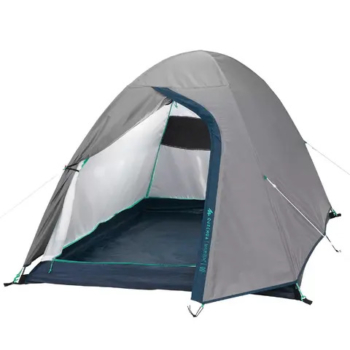
The QUECHUA MH100 is an ultra light two person tent that is simple and easy to set up. It has passed all the durability and waterproofing tests and is the best entry-level alternative of the moment.
20 £ on DecathlonIn addition to its low weight, the self-supporting structure of this ultra-light QUECHUA MH100 dome-shaped tent allows you to move it easily once assembled. It is a double-roofed model that, in addition to the main door at the front, offers a ventilation system at the back. The living area is 210 cm long and 130 cm wide, with 65 cm of space for each person.
The main asset of this ultra light tent QUECHUA MH100 is its wind resistance of Force 5. Thus, this model can resist to a wind speed of 40 km/h.
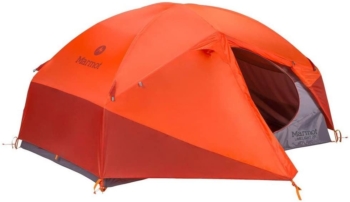
The Marmot Limelight is an ultra-lightweight tent offering unprecedented comfort. It feels more spacious than its dimensions suggest, and its two large side doors make it easy to get in and out. It also has large storage pockets on two levels.
317 £ on AmazonThis ultra-lightweight tent offers more comfort than it first appears. Although on paper its length is comparable to many of the other tents in this comparison, its interior length of 220cm, interior width of 135cm and peak height of 109cm set it apart. Two people can easily sit in it at the same time, which is not the case for all the ultra-light tents in this selection.
The weather resistance of the Marmot Limelight is more than satisfactory. It does a good job of keeping the rain out. Finally, note that the Marmot Limelight is made from poly 68 taffeta, which is less elastic than ripstop nylon, but thicker to offer plenty of resistance to puncture.

The Terra Hiker is a versatile product that can be used as a traditional tent, but also as a large rain poncho or umbrella. It is also the only 4-season tent in this selection, so it deserves its place here.
119 £ on AmazonOnce unfolded, this ultra-light tent from Terra Hiker offers a lot of space and comfort. You benefit from an interior surface of 205 cm long and 135 cm wide. It weighs just over 2 kg and does not weigh down your pack.
We appreciate in particular the double thickness protection materialized by an interior in breathable nylon and a base in reinforced nylon 20 D. We also find a layer of silicone guaranteeing a waterproofness of 4000 mm. Here, the design of the structure was purified to improve the wind resistance. We notice that this model has two doors and a ventilation window to optimize ventilation.
Any specific needs?
Best entry-level ultra light tent
Best high-end ultra light tent
Your guide :
Rate this buying guide :By rating this buying guide, you are helping us to reward our best writers. Thank you!
| The best | Inexpensive | Top of the line | Excellent | |

In accordance with our commitment, this buying guide does not contain any sponsored products. |
 9/10 |
 7/10 |
 8/10 |
 8/10 |
| OUR SELECTION |
Naturehike Cloud-Up
|
QUECHUA MH100
|
Marmot Limelight
|
Terra Hiker ultra light tent
|
|
The first thing you notice about the Naturehike Cloud Up 2 tent is how compact and light it is when packed up. It fits perfectly in the ultra-light category with an excellent price/performance ratio.
|
The QUECHUA MH100 is an ultra light two person tent that is simple and easy to set up. It has passed all the durability and waterproofing tests and is the best entry-level alternative of the moment.
|
The Marmot Limelight is an ultra-lightweight tent offering unprecedented comfort. It feels more spacious than its dimensions suggest, and its two large side doors make it easy to get in and out. It also has large storage pockets on two levels.
|
The Terra Hiker is a versatile product that can be used as a traditional tent, but also as a large rain poncho or umbrella. It is also the only 4-season tent in this selection, so it deserves its place here.
|
|
|
Type
|
Modified A-frame
|
Dome frame
|
Dome frame
|
Dome frame
|
|
Total packed weight
|
1.85 kg
|
2.4 kg
|
2.55 kg
|
2.15 kg
|
|
Living area (L x h x w)
|
210 x 105 x 130 cm
|
210 x 105 x 130 cm
|
220 x 109 x 135 cm
|
205 x 110 x 135 cm
|
|
Denier
|
20D
|
10D
|
20D
|
20D
|
|
Waterproofing index (double-roof)
|
4000 mm
|
2000 mm
|
2000 mm
|
4000 mm
|
Help us improve this table:
Report an error, request the addition of a feature to the table, or suggest another product. Thank you for your kindness!
We spend thousands of hours each year studying the major specialized websites, analyzing products of hundreds of brands and reading user feedback to advise you on the best products.
We are a product review company with a single mission: to simplify your buying decisions. Our research and testing helps millions of people every year find the best products for their personal needs and budget.
To support us you can: use our links to make your purchases (which often earns us a small commission), share our articles on social networks, or recommend our site on your blog. Thanks in advance for your support!
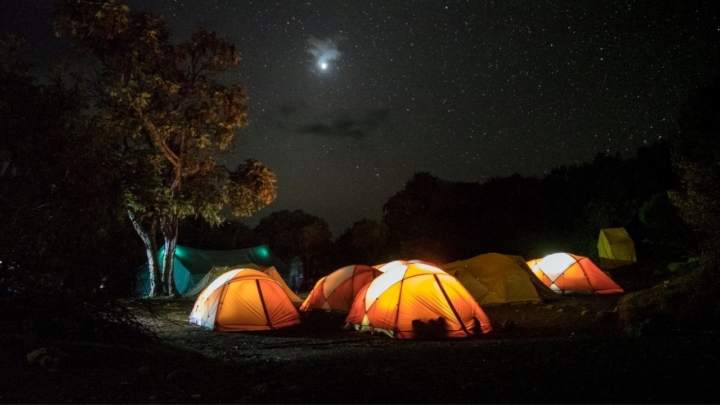
The interior space (or "living" space) means the space in which you will sleep, change clothes. With interior space, you can determine how comfortable you will be in that space, whether or not you share it with another person. The slope of the walls and the maximum height of the roof also contribute to the living space. A sloping wall from floor to top means less shoulder room, while a tent with a spreader bar on top and more vertical walls equals more shoulder room and room to sit without bumping into the steep walls. The standard floor area of a tent is a good starting point for estimating "living space."
Ultra-light tents need to be treated with care. Regardless of price and quality, if the denier of your tent's walls and floor decreases, the durability also decreases and the tent is more prone to tears or punctures. For tents with a ground denier of less than 30 D, be very careful where you set them up and avoid roots and sharp rocks. "Denier" is the term used to describe the thickness of the tent fibers. Thus, a 20 denier (or 20 D) fabric has 2/3 the density of a 30 D fabric. Many tents will have a higher denier fabric on the tent floor than on the wall. A 20D DCF tent wall will wear differently than a 20 D nylon tent wall.
If you just need a tent to throw in your trunk for RV adventures, size and weight are probably not a major concern. If weight isn't an issue, don't be afraid to go big. Most tents will have a recommended number of occupants. When kids, dogs, friends, chairs and all sorts of accessories need to fit in the tent, the bigger the better. On the other hand, if you're looking for a trustworthy tent to carry on hikes in the woods or mountains, weight and size make a big difference.
Condensation management and ventilation are important considerations when choosing an ultralight tent. Some models are better ventilated than others, but it also depends on how you set up your tent and where your site is located. Double-wall tents handle condensation better. The potential for excessive condensation is a disadvantage of single-wall tents, but it's starting to be addressed on various models. Tent models with doors on both sides allow for cross-ventilation options, which is essential to avoid condensation. Proper ventilation of your tent helps prevent condensation buildup, as airflow moves water vapor out of the tent.
There are a few things to consider when it comes to weather protection in an ultra-light tent: precipitation from above and soaking from below. Some tents are not fully sealed and you'll need to waterproof and seal the seams yourself. For other brands, this is an additional option. Always try to determine if your tent is fully waterproof before you buy and use it for the first time.
An ultralight tent is made of synthetic fabrics, metal, plastic and waterproof liners that require care to last and function. There is a common misconception that because these materials are strong and designed to resist moisture, they can survive harsh conditions, even those we occasionally impose on them. While tents are designed to protect against the elements, their durability depends on proper care and treatment.
As with many man-made items, moisture is the biggest challenge to keeping a tent fully operational. Removing moisture before storing the tent keeps the materials strong and waterproof. The same goes for cleaning your tent. Dirt and grime also weaken materials.
There are many things you can do to protect your tent.
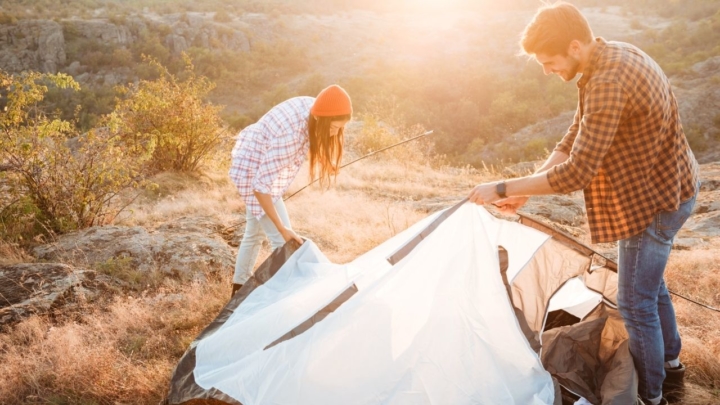
Preparing your tent for setup is the first step. Choose a flat, level spot and remove any twigs or rocks that might poke holes in your tent floor. Next, make a footprint to protect your tent from ground moisture. This can be a synthetic ground cover. If you keep your tent in the same space for several days, it is best to be in the shade. Tent fabric does not handle ultraviolet rays well, and tree cover is a great way to keep it from decaying. Note that the rain fly is probably the most sun-resistant part of the tent, so it's a good idea to keep it on during the day.
The first thing to do when you take down your tent is to shake everything out, including the footprint and the tent itself. If you can pick up your tent with the poles still in place, it will be much easier to shake out the dirt. Some tent poles pass through sleeves on the outside of the tent for easy removal. When removing them, push them out instead of pulling. Pulling causes the pole segments to separate and catch on the fabric, which then puts pressure on the drawstring. When you have released the poles, break them apart starting in the middle, then continue to split the segments in half.
Dry your tent thoroughly before putting it in a storage bag or carrying case. There's little chance that moisture hasn't accumulated somewhere on the tent, and putting it in the bag is an invitation for mold. Also, when you put it in the bag, roll it up instead of putting it inside.
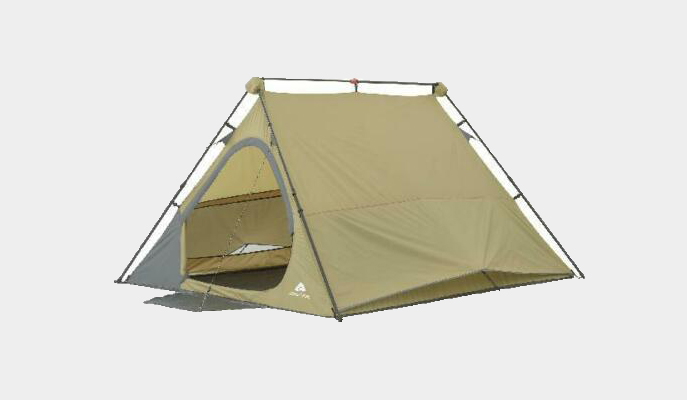
As the name suggests, an ultra-lightweight A-frame tent looks like a big "A". Simple, lightweight and often inexpensive, A-frame models have sloping walls, which can limit head and elbow room. Because their wide sidewalls can be battered in high winds, A-frames are best for mild conditions. Originally made of canvas with metal or wood poles, newer models are made of lighter materials. This tent is easy to pitch and surprisingly stable, but it is bulky when packed and lacks headroom inside.

Domes come in many shapes, sizes, and pole configurations, but generally feature vaulted ceilings, good wind stability, and good interior space. Ultra-lightweight dome tents consist of two poles that intersect to form the tent structure. The dome shape of the tent allows the wind to move easily over the tent. Water will also fall down the sides of the tent instead of collecting on top.
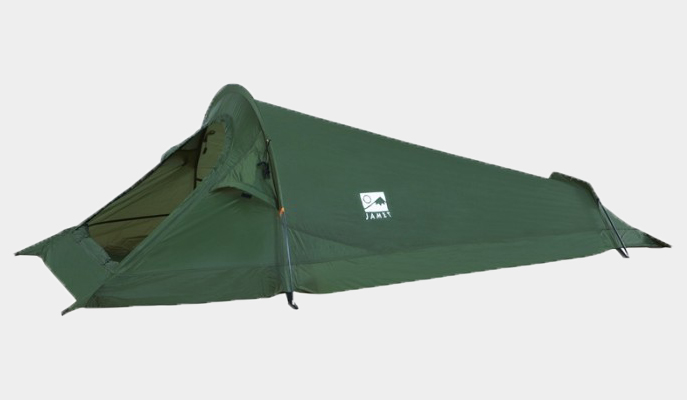
Tunnel or tube-shaped tents offer a good combination of weight and weather resistance, but they are not freestanding, which means they require a proper pole to achieve their shape. They consist of two or more curved poles connected by the tent fabric. The pole design creates a tunnel that has a constant ceiling height. Some ultra-light tunnel tents have large storage areas. In theory, there is no limit to the number of poles that tunnel-style ultralight tents can have. Therefore, they are available in several different sizes.
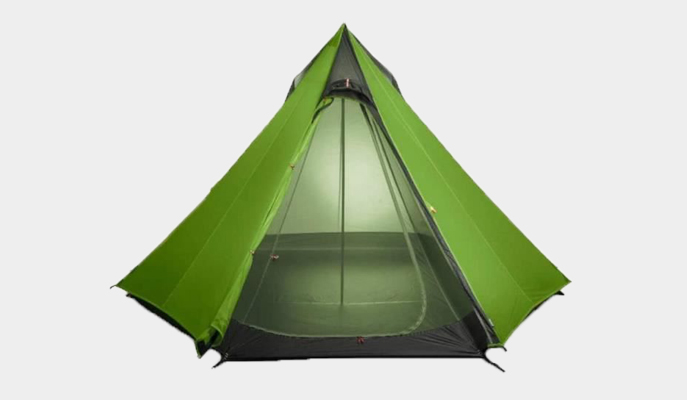
This type of ultra light tent consists of a double roof supported by a vertical center pole that are staked to form a teepee shape. The advantage of having only one pole is that the tent becomes very light. Some pyramid tents can even be erected with simple hiking poles. The space-to-weight ratio is excellent, but the groundless design means poor performance against the elements, especially in wet weather. Also, outside of the ultralight packer community, ultra-light pyramid tents are not at all popular. The center pole creates an uncomfortable sleeping area. The walls are very slanted, so interior space is limited.
This is the most traditional design of ultralight tent and tent. Self-supporting ultralight tents come with a frame of poles specifically designed for this model of tent. These help the tent stand 100% (or nearly 100%) upright or simply "freestanding". They still use stakes and guy wires for stability, but do not rely on them to stand upright. A freestanding tent can be set up virtually anywhere from soft surfaces (sandy beach) to hard surfaces (rocky summit) where stakes are ineffective. A freestanding tent also offers more stability against strong winds because more metal is used. It should also be noted that the metal frame is usually very quick and easy to set up.
Non-self-supporting tents or trekking tents that strive to be ultra-light by abandoning the poles in the tent are gaining in popularity. This configuration requires you to carry poles with you to support the body of the tent. Hiking or trekking poles can serve as excellent, sturdy removable poles, but they don't bend like regular tent poles. As a result, these trekking tents tend to be more rectangular than dome-shaped. Non-self-supporting tents tend to have a lower roof than self-supporting tents. This low profile allows the wind to blow over the tent more easily. Also, there is a learning curve for setting up a non-self-supporting tent.
The choice between freestanding and non-self-supporting tents comes down to weight. If you're an ultralight hiker looking for the lightest tent possible, a non-self-supporting design is the way to go. Especially if you plan to carry hiking poles.
The terrain you're camping on is another important consideration. If you're camping on rocky or sandy surfaces or on wooden tent platforms, you may find it easier to use a freestanding tent, as it's more versatile and can stand upright on its own.
A third choice is to choose a semi-self-supporting model. Some manufacturers offer these models, which are somewhere between freestanding and non-self-standing tents. This configuration is less common, but seems to be gaining in popularity. Semi-self-supporting tents typically use a single pole that takes the shape of a "Y" or "T". This pole holds the tent upright when the tent is not attached. In this sense, the tent is self-supporting. To maximize interior space and stabilize the pole in place, the tent must still be staked.

1. to reduce weight
First of all, the main reason to buy an ultra light tent is already the name. It is to save weight. If you are hiking alone, there is enough essential equipment. Food, pots and pans, stove, first aid kit, weather gear, sleeping bag..., all of this adds pounds to your backpack. So an ultra-light tent can significantly reduce the weight of your backpack, which means less strain on your body and less energy expenditure. You can walk farther and for longer.
2. So that older people can continue hiking or camping
Many people have decided to give up the backpack, because it can be quite demanding on our bodies, and when the years add up, they can no longer carry all the necessary equipment. Going light is the best way to continue your favorite hobby. Gaining weight allows people who are no longer so young and strong to continue to enjoy their favorite outdoor activities.
3. To enjoy the same practicality as heavier tents
Backpacking gear is constantly being improved, and light weight is no longer associated with a lack of functionality. An ultra-light tent offers all the features and comfort of a heavier tent, which is extremely important when it comes to hiking. Nowadays, manufacturers have quality materials available that are durable, can provide warmth on cold nights, and at the same time, are much lighter than traditional tent materials.
4. To cover a longer distance
The lighter your tent is, the less weight you carry, allowing you to cover more distance. An ultra-light tent will allow you to cover a wider area. The deeper you go into the forest, the fewer crowded trails you'll use and the more enjoyable your hike will be. Also, shorter days in early spring or late fall mean less distance covered, but you can compensate for that with a lighter tent.
5. To carry extra gear
By getting an ultra-light tent, you have more space and can carry extra camping gear. More gear can enhance your backpacking experience, providing more comfort and functionality. Every ounce counts when you're camping or hiking, and longer trips usually require more gear. With an ultra-light tent, bringing everything you need is no longer a problem.
In our opinion, the best brands of ultra light tents in 2022 are :
Quechua is the French registered trademark for the hiking and camping clothes and equipment marketed by Decathlon. So, it is under the Quechua label that Decathlon offers its tents. If you are wondering if Quechua sells good ultra-light tents, the answer is yes!
We know this brand for its sleeping bags, air mattresses and camping mats. Recently, Active Era also offers beach tents and 2-person hiking tents. The prices should be more suitable for small budgets. But the quality is definitely there!
Marmot is an outdoor clothing and sporting goods company founded in 1974 as "Marmot Mountain Works". Marmot tents are known for their excellent build quality and ease of setup.
NatureHike is fairly well known in the camping community. It manufactures sleeping bags, air mattresses and various shelters, among other things. This brand has a few tents worth checking out, including the Taga and Opalus.
This brand specializes in large tents that can sleep 8 people, or even 12 like the Skandika Nimbus 12. It also makes fitness equipment and hiking backpacks. For family camping, treat yourself to a Skandika tent.
The diagram below will help you to get an idea of the typical prices for each price range (entry-level, mid-range and high-end).
However, more expensive does not necessarily mean better.
We therefore advise you to always consult our ranking before deciding, rather than blindly relying on price ranges.
Test your tent at home
Don't wait until your first outing to set up your new tent for the first time. Setting up can sometimes be tricky until you get familiar with how the poles fit and connect to the tent body, and the last thing you want is to take a long time to set up your tent at night after a long hike. So, do some testing at home.
Seal the seams
Make sure all the seams on your roof and tent floor are sealed by the manufacturer. If not, you'll need to apply a seam sealer to prevent water from seeping into the seam holes.
Pad the floor of your tent
Think about creating a floor mat for your tent. It will protect the floor from abrasion. One thing you'll want to make sure is that the groundsheet is slightly smaller than the actual floor area of the tent to prevent water from seeping underneath.
You can always lighten your pack
Even with an ultra-lightweight tent, you can still lighten your pack. Indeed, when you have an ultra-light tent, you're always tempted to bring a little more stuff (extra clothes or bottles), but if there's a chance you won't use them, it's not worth carrying them on your back. You should also eliminate duplicates (no extra cups or spoons). We also recommend that you bring one of everything: t-shirt, shorts, pants, etc.
Reinforce the guy wires
especially for convertible tents and mountain tents, identify all guy loops on the outside of the flysheet and pre-tie the guy lines at each strategic point. Do this to avoid fumbling if you have to pitch your tent at night or in bad weather. The guy wires can greatly increase the stability of the tent in high winds.
There are two types of wall fabric: a tarp-like flysheet used as a barrier and a mesh wall used as an enclosure to keep insects out. A single-wall tent is usually just a tarp wall. Single-wall tents are light, fast and compact. A double-wall tent is usually a combination of a tarp wall and a mesh wall. Double-wall tents usually guarantee a dry living area, because the extra wall protects against the accumulation of drip condensation inside.
Look carefully at the square footage when choosing an ultra-light tent, and don't rely on a tent's designation as a 1 or 2 person tent. Most backpackers choose a one-person tent to save weight and money, but these tents can often be too small. Some choose a two-person tent because it gives them extra room to stretch out and store their gear inside the tent. Other hikers travel with a partner, so a 2-person tent is a must.
For a two-person tent, two doors are ideal. Having two doors avoids crawling all over each other when you need to go to the bathroom, for example. Two doors also give you better ventilation. However, two doors means two zippers, which adds to the weight of the tent. This can be a matter of convenience and comfort versus weight. Many people looking to keep the weight of their pack as low as possible will be satisfied with one door, either on the side or front of the tent.
When you want to store your tent, it is imperative to make sure the tent is clean and completely dry. Don't crumple it up in a storage bag, instead fold it neatly and store it flat to avoid degradation of the waterproof seams. Many ultra-light tents and standard single-wall tents have 15D or even 10D grounds. In this case, you should seriously consider protecting the base of your tent.
Every month we help more than 1 000 000 people buy better and smarter.
Copyright © 2022 - Made with ♥ by buyingbetter.co.uk
Your reviews and buying guides 0% advertising, 100% independent!